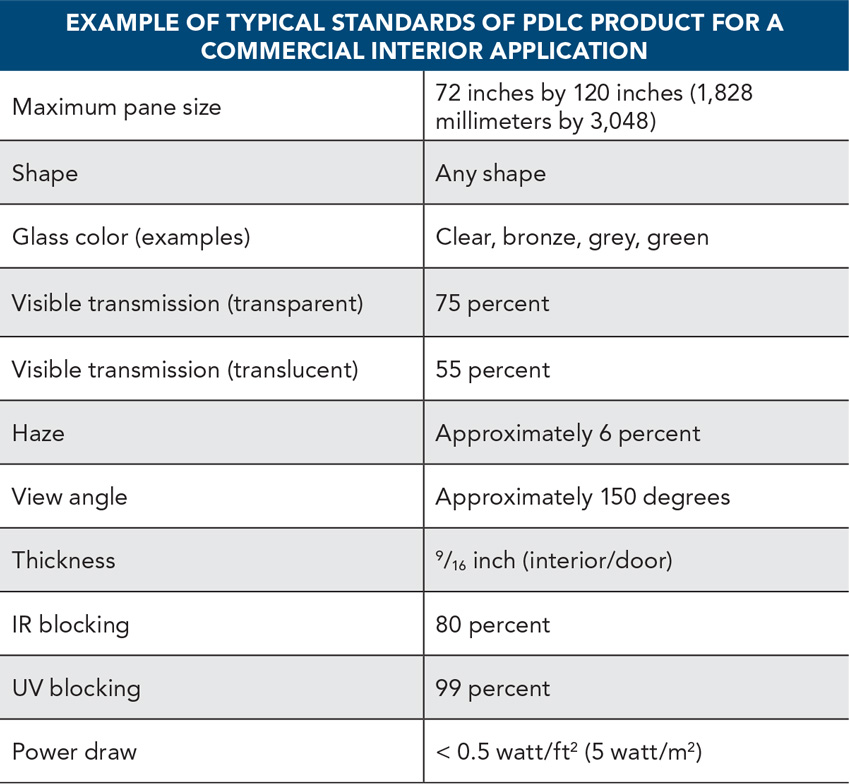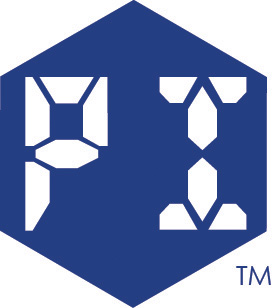This CE Center article is no longer eligible for receiving credits.
How PDLC Technology Works
We’re all familiar with liquid crystal display (LCD) applications that we see in our daily lives—they’re everywhere, from our flat-panel television screens, personal computers, and smart phones to digital watches, clocks, and calculators. How many of us, though, stop to consider how this technology works? It’s really quite simple. The liquid crystals are arranged in a matrix array (millions for LCDs), and when electricity is applied, the light is manipulated differently, allowing light to pass through individual elements. This action forms the figures, numbers, and other images we see displayed. PDLC takes it a step further, whereby liquid crystals aren’t arranged in matrix arrays but rather in domains where the microscopic liquid crystal droplets can react synchronously with other droplets to an applied electric field.

Images courtesy of Polytronix, Inc.
With PDLC products, when the power is turned on, the liquid crystals align and the window is clear. When the power is turned off, the liquid crystals return to their normal scattering positions and the glass becomes a translucent white pane, providing total privacy. Pictured here is the technology at work in a hospital setting.
With PDLC products, when the power is turned on, the liquid crystals align and the window is clear. The power draw is very low—just 0.5 watts/square foot. When the power is turned off, the liquid crystals return to their normal scattering positions and the glass becomes a translucent white pane. Generally speaking, in its opaque state, more than 96 percent of the parallel light is blocked. This results in a high level of privacy, although half of the total light transmits through the glazing. When switched to a clear state, you can see through the material like you would with a traditional piece of glass, with approximately 75 percent total light transmission.
PDLC glazing is a sandwich of conventional glass laminated to liquid crystal technology. A typical interior glazing unit is made of a sheet of 5- or 6-millimeter annealed glass on each side, with the liquid crystal switchable privacy film packaged in between. The film package consists of two layers of transparent conductive films enclosing PDLC material. The film includes electrical wiring that connects to a transformer, which supplies power for the pane’s operation.
PDLC is a medium whose light-scattering power is adjustable through applying an electric field. In their natural (uncharged) state, the PDLC droplets randomly align. The ordinary refractive index of these liquid crystals does not match that of the polymer so the incident light is scattered white translucent. When an electric field is applied across the material, the PDLC droplets reorient and incident light can pass through, resulting in the transparent state.
According to Sang Lam, senior business development manager for Polytronix, Inc., “PDLC technology looks like glass, but it’s actually film based. In fact, making the switchable film is a different field in and of itself. The film construction consists of two pieces of film with a proprietary liquid crystal mix that gets sandwiched in. The manufacturer will put electrodes on, allowing the film to be turned on and off. The film is what essentially creates the ‘magic’ for PDLC.” Lam adds that the glass construction is a separate piece of the puzzle. You take that switchable film and sandwich it between two pieces of glass using an adhesive (interlayer), such as polyvinyl butyral (PVB), thereby protecting the film within the glass.
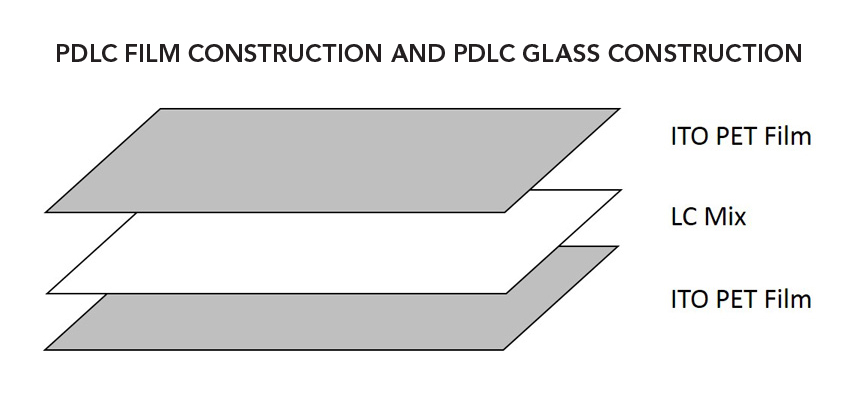
Image courtesy of Polytronix, Inc.
PDLC film construction
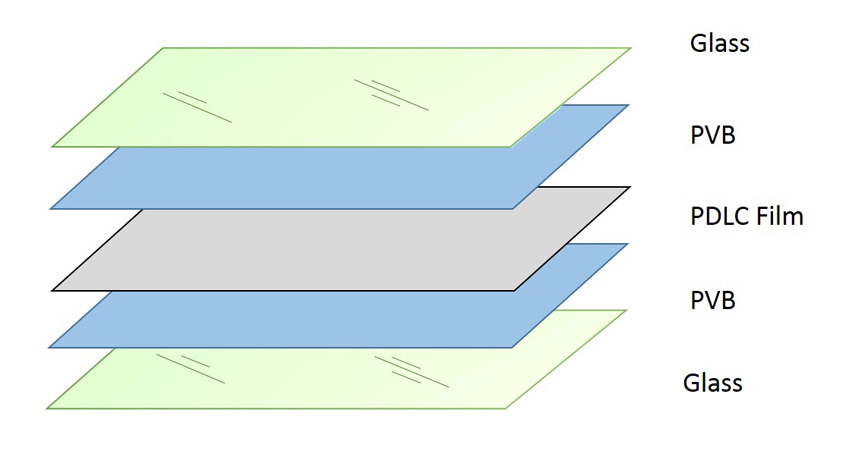
Image courtesy of Polytronix, Inc.
PDLC glass construction
Types of PDLC Switchable Products
There are two distinct smart glass products that utilize PDLC technology. Usage of each would depend upon the specific needs of a project. Generally speaking, for quick retrofits with low or moderate costs, self-adhesive films would be the right option. Alternatively, for new builds and renovations meant to last, the laminated PDLC glass would likely be the better choice. Here we will take a quick look at these two product types: laminated switchable PDLC glass and self-adhesive switchable PDLC film.
Laminated Switchable PDLC Glass
There are three different types of glass that can be used in laminated switchable PDLC glass:
- Annealed (weakest)
- Chemically strengthened (about two times stronger)
- Tempered glass (about four times stronger)
All three will exude a greenish tint due to the iron content in the glass. Annealed and tempered glass can be made with a low-iron content, which would give those types a whiter appearance.
Self-Adhesive Switchable PDLC Film
With self-adhesive switchable PDLC film, the adhesive layer is applied directly onto the window, just like a window tint. The self-adhesive film utilizes a dry, or a nonaqueous, application. That is, no water or other aqueous solutions are needed to apply the film to an existing glass panel. Care should be exercised to properly insulate the wiring so as to avoid electrical shock.
As the smart glass industry rapidly expands, more and more architects and designers are getting smart about how to use this state-of-the-art technology to enhance a wide range of commercial projects. Switchable privacy glass, in particular, which uses a liquid crystal technology known as polymer dispersed liquid crystal (PDLC) film, can provide users with greater privacy benefits than other traditional methods—and even other smart glass technologies. This PDLC technology, which is sandwiched between two layers of glass and two layers of conductive interlayers, allows for the visual appearance of the glass to change from opaque to clear (or to dim settings in between) with the flip of a switch.
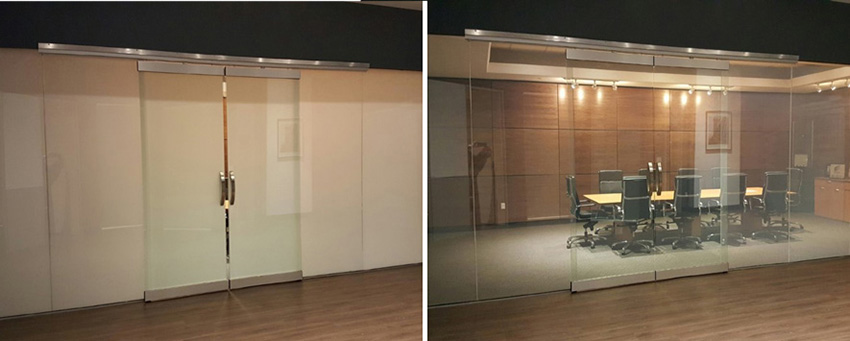
Photos courtesy of Polytronix, Inc.
This newly updated executive conference room utilizes PDLC smart glass technology for on-demand privacy with the flip of a switch.
Over the years, the glass and window coverings industry has evolved from curtains to blinds to integral blinds/roller shades (manual and automatic). Now, as an offshoot to this market, there is smart glass—an innovative option in that it is more like an electronic device than more traditional products. In this course, we will look at the various benefits accorded to interior commercial applications by the use of electronic switchable privacy glass and how this technology has revolutionized the way people look at their privacy options for windows and doors.
Overview: Smart Glass Basics
In the most basic terms, smart glass is glass that varies its light transmission properties under light, thermal, or electrical influences. There are two general categories of smart glass: passive (light, heat/natural) and active (electrical/on demand). In the passive category, there are multiple subcategories, including thermochromic and photochromic (transition lenses). In the active category, there are three subcategories: electrochromic (EC), suspended particle devices (SPD), and polymer dispersed liquid crystal (PDLC).
Passive
Passive smart glass technologies are those that use natural, nonelectrical stimuli, such light and heat, to transition from dark to light. They cannot be controlled manually. These include thermochromic, which reacts to heat, and photochromic, which responds to light.
Thermochromic: Thermochromic glass, as its name suggests, uses heat from direct sunlight to tint the windows on an as-needed basis. As the amount of direct and intense sunlight increases on the glass, the darker it becomes. Typical applications include external windows where, for example, there will be changes in transparency based on the season, temperature, and amount of light. (For example, the window might be clear during cold winter months and tinted during the warmer summer months when heated by direct sunlight and there is more light on a daily basis.)
Photochromic: Photochromic materials will change level of transparency in response to the intensity of light. The most typical use of these materials is in eyeglasses that change from clear to dark based on whether the wearer is in dim indoor light or in bright outdoor light (i.e., transition lenses).
Active
Active smart glass technologies are those that respond to an electrical stimulus, which allows them to be controlled by the user, providing on-demand results.
Electrochromic (EC): This material can switch its color by the application of an external DC voltage or current, using electricity to turn the glass from clear to dark. Typical use includes solar control for exterior glass. In the darkest state, the visible light transmission can be less than 3 percent. Shading offers limited privacy as it can still be seen through.
Suspended particle devices (SPD): These are small light-absorbing microscopic particles (aka light valves), which allow windows to go from clear to dark in a matter of seconds in response to an external AC power source. When voltage is applied, the suspended particles align, allowing light to pass. This technology is generally used for light-control applications—most commonly auto glass, skylights, sunroofs, as well as portholes and marine and aircraft windows. It provides weak to moderate privacy.
Polymer dispersed liquid crystal (PDLC): This innovative liquid crystal technology switches from opaque to clear in milliseconds using AC power, regardless of the window size. It has light-scattering power, which can be adjusted by applying an electric field, and can be used for a range of interior and exterior applications. Products using this technology are available in a self-adhesive switchable film that can be applied to existing window surfaces as well as a laminated switchable glass. In its opaque state, it provides total privacy—that is, it cannot be seen through.

Source: Polytronix, Inc.
If you’re looking for full privacy benefits and speed, you would choose PDLC products over other types of smart glass, as PDLC is a true privacy solution.
How PDLC Technology Works
We’re all familiar with liquid crystal display (LCD) applications that we see in our daily lives—they’re everywhere, from our flat-panel television screens, personal computers, and smart phones to digital watches, clocks, and calculators. How many of us, though, stop to consider how this technology works? It’s really quite simple. The liquid crystals are arranged in a matrix array (millions for LCDs), and when electricity is applied, the light is manipulated differently, allowing light to pass through individual elements. This action forms the figures, numbers, and other images we see displayed. PDLC takes it a step further, whereby liquid crystals aren’t arranged in matrix arrays but rather in domains where the microscopic liquid crystal droplets can react synchronously with other droplets to an applied electric field.

Images courtesy of Polytronix, Inc.
With PDLC products, when the power is turned on, the liquid crystals align and the window is clear. When the power is turned off, the liquid crystals return to their normal scattering positions and the glass becomes a translucent white pane, providing total privacy. Pictured here is the technology at work in a hospital setting.
With PDLC products, when the power is turned on, the liquid crystals align and the window is clear. The power draw is very low—just 0.5 watts/square foot. When the power is turned off, the liquid crystals return to their normal scattering positions and the glass becomes a translucent white pane. Generally speaking, in its opaque state, more than 96 percent of the parallel light is blocked. This results in a high level of privacy, although half of the total light transmits through the glazing. When switched to a clear state, you can see through the material like you would with a traditional piece of glass, with approximately 75 percent total light transmission.
PDLC glazing is a sandwich of conventional glass laminated to liquid crystal technology. A typical interior glazing unit is made of a sheet of 5- or 6-millimeter annealed glass on each side, with the liquid crystal switchable privacy film packaged in between. The film package consists of two layers of transparent conductive films enclosing PDLC material. The film includes electrical wiring that connects to a transformer, which supplies power for the pane’s operation.
PDLC is a medium whose light-scattering power is adjustable through applying an electric field. In their natural (uncharged) state, the PDLC droplets randomly align. The ordinary refractive index of these liquid crystals does not match that of the polymer so the incident light is scattered white translucent. When an electric field is applied across the material, the PDLC droplets reorient and incident light can pass through, resulting in the transparent state.
According to Sang Lam, senior business development manager for Polytronix, Inc., “PDLC technology looks like glass, but it’s actually film based. In fact, making the switchable film is a different field in and of itself. The film construction consists of two pieces of film with a proprietary liquid crystal mix that gets sandwiched in. The manufacturer will put electrodes on, allowing the film to be turned on and off. The film is what essentially creates the ‘magic’ for PDLC.” Lam adds that the glass construction is a separate piece of the puzzle. You take that switchable film and sandwich it between two pieces of glass using an adhesive (interlayer), such as polyvinyl butyral (PVB), thereby protecting the film within the glass.

Image courtesy of Polytronix, Inc.
PDLC film construction

Image courtesy of Polytronix, Inc.
PDLC glass construction
Types of PDLC Switchable Products
There are two distinct smart glass products that utilize PDLC technology. Usage of each would depend upon the specific needs of a project. Generally speaking, for quick retrofits with low or moderate costs, self-adhesive films would be the right option. Alternatively, for new builds and renovations meant to last, the laminated PDLC glass would likely be the better choice. Here we will take a quick look at these two product types: laminated switchable PDLC glass and self-adhesive switchable PDLC film.
Laminated Switchable PDLC Glass
There are three different types of glass that can be used in laminated switchable PDLC glass:
- Annealed (weakest)
- Chemically strengthened (about two times stronger)
- Tempered glass (about four times stronger)
All three will exude a greenish tint due to the iron content in the glass. Annealed and tempered glass can be made with a low-iron content, which would give those types a whiter appearance.
Self-Adhesive Switchable PDLC Film
With self-adhesive switchable PDLC film, the adhesive layer is applied directly onto the window, just like a window tint. The self-adhesive film utilizes a dry, or a nonaqueous, application. That is, no water or other aqueous solutions are needed to apply the film to an existing glass panel. Care should be exercised to properly insulate the wiring so as to avoid electrical shock.
Lighting Conditions and Haze in Regular and PDLC Glass
As previously noted, one of the most common misconceptions relates to clarity of the PDLC technology because of customers’ preexisting expectation that the optical clarity will be the same as with regular float glass. That level of clarity is not possible with PDLC products, however, as they contain liquid crystal materials that optically manipulate light; therefore, glass products with PDLC technology naturally have some level of haziness to them (even regular glass has some haze, albeit at much more extreme lighting conditions). This haziness effect with PDLC glass products is magnified at larger viewing angles and with certain high-intensity lighting conditions. This, however, does not detract from its wide-ranging use as a practical alternative.
Clarity Standards and Guidelines
The photos below illustrate the haze effect in both regular and PDLC glass. The first set of images shows how hazy regular glass can appear in direct sunlight compared to a scenario with no direct sun. The second set of images (of the conference room) shows how the different lighting conditions affect the PDLC panels. The acronyms O.I. and I.I. stand for outside intensity and inside intensity, respectively, as it pertains to the light intensities outside and inside the conference room. There are four scenarios depicted here: 1) the lighting condition is worse when the O.I. is much greater than the I.I.; 2) the haze improves when the O.I. is only slightly greater than I.I.; 3) the optimum haze condition is when the O.I. is the same as the I.I.; and 4) the best/reference condition for haze is when no lights are on. It is advisable, then, for architects and designers to consider the placement of any lighting near the privacy glass.
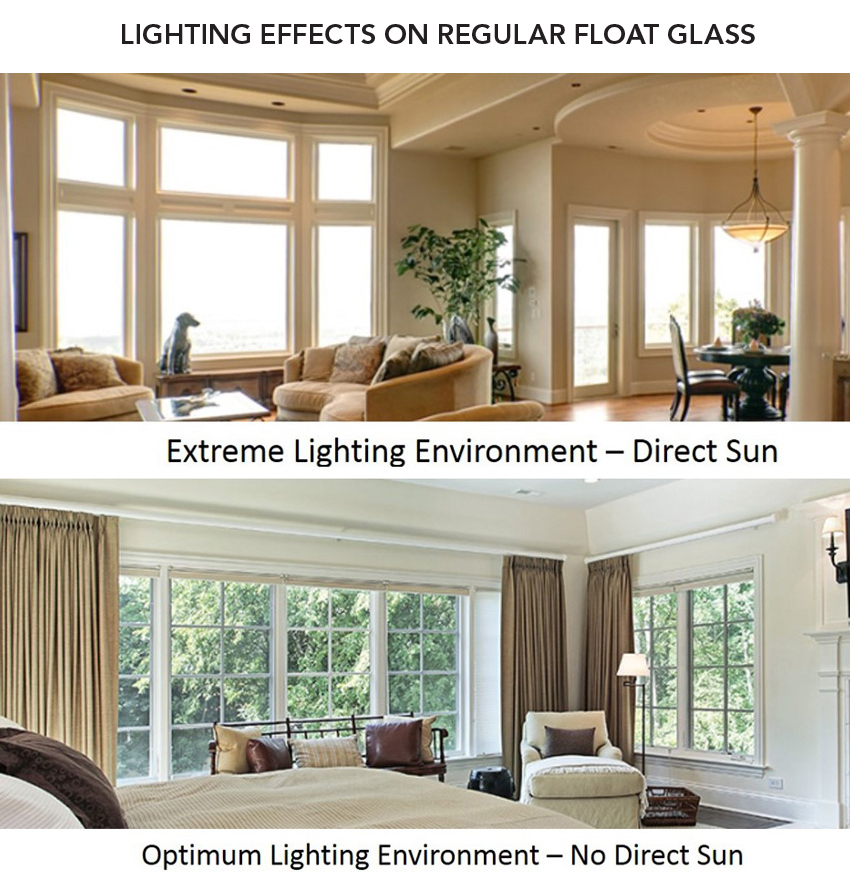
Photos courtesy of Polytronix, Inc.
Lighting has a big effect on the clarity of glass. Even regular, monolithic glass will exhibit some haze when exposed to extreme lighting conditions. The haze effect is magnified, especially in direct sunlight.
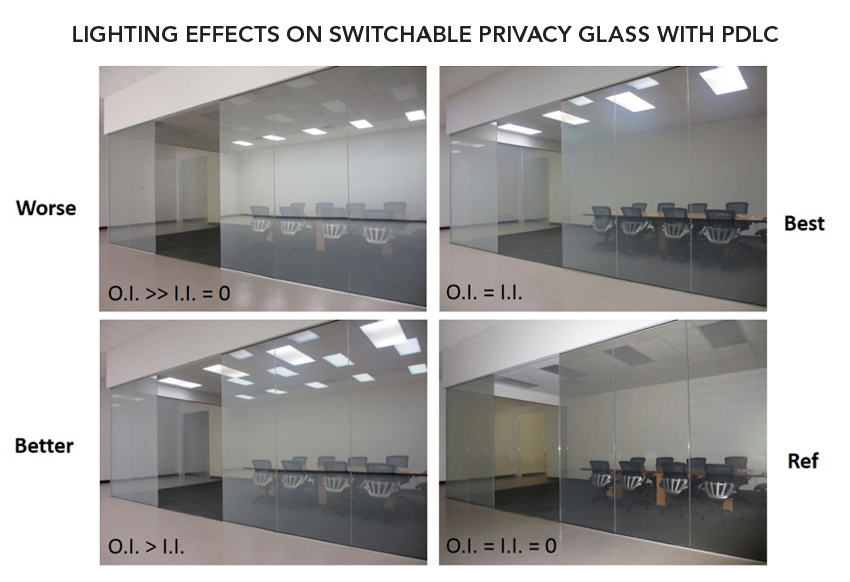
Photos courtesy of Polytronix, Inc.
The photos here were taken at the same distance and angle for a precise measurement of lighting conditions. Here is how specific lighting conditions affect haze.
1. Worse lighting conditions: Lights that are only on the outside of the conference room will cause an imbalance in light intensity. This will increase the haze.
2. Better lighting conditions: Lights on the outside of the conference room are higher in intensity than on the inside. This will result in a slight haze.
3. Best lighting conditions: Lights on the inside of the conference room and outside are evenly balanced in intensity and sufficiently diffused at appropriate distances.
4. Low haze in dark state (all lights off): No lights on the inside or outside of the conference room will result in little haze.
PDLC glass is also a light diffuser and the clarity can be impacted based on an imbalance of light intensities in the surroundings. The image below shows the difference in clarity between using fluorescent lighting (diffusive, large area, public) and LED lighting (directional, focused, small area, more intimate).
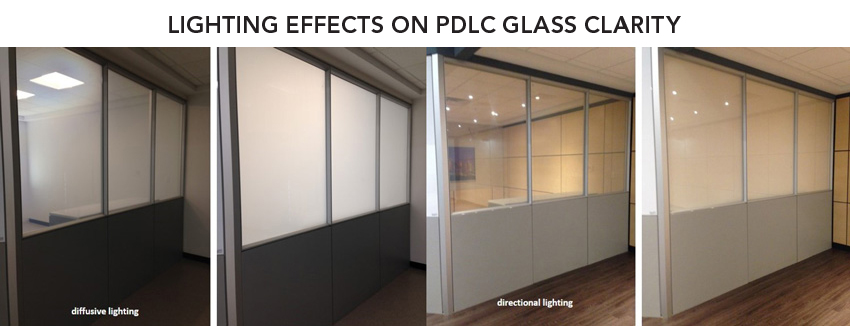
Photos courtesy of Polytronix, Inc.
Using fluorescent lighting (two photos on left) or LED lighting (two photos on right) will affect the clarity and appearance of the PDLC glass. Appearance is also used to address the “whiteness” in the opaque mode with the two different lighting scenarios.
Additional Haze Factor Considerations
As discussed, PDLC glass contains liquid crystal (LC) material, therefore it inherently possesses some level of “haziness” and would not exhibit the same level of clarity as regular float glass. In addition, the inherent haziness is increased at wider viewing angles and with big disparities in light intensities (see diagram below). This phenomenon is normal because typical PDLC film/glass is a light diffuser and will change in haze at varying viewing angles as well as lighting conditions, as previously noted.
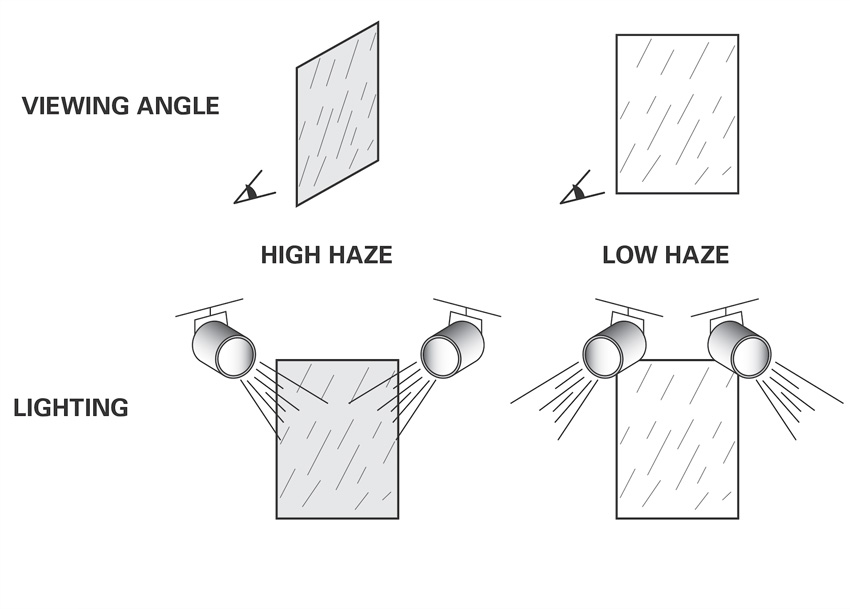
Image courtesy of Polytronix, Inc.
Typical PDLC film/glass is a light diffuser and will change in haze at varying viewing angles as well as lighting conditions
Features and Benefits
The PDLC switchable privacy glass application can be used in many innovative ways. Here is a summary of some of the main features and benefits of using PDLC switchable privacy glass:
- Aesthetic and clean: visual attention to interior (and exterior)
- Offers privacy on demand
- Provides privacy and security with architectural integrity
- Projectable/can be used as a whiteboard: eliminates need for projection screens and dry erase boards
- Safety glass (standard): panels should meet safety glass requirements
- Can be made into impact-resistant glass (i.e., bulletproof, hurricane rated)
- No distracting shutters and drapes
- Saves energy by using natural lighting while maintaining privacy
- Environmentally friendly: reduces the waste associated with manufacturing curtains or drapes, low power consumption, blocks more than 99 percent ultraviolet light
We will look at some of these benefits in more detail later in this course.
Standards and Codes
While industry codes do not regulate directly smart glass product per se, smart glass does meet a number of federal safety and regulatory codes due to the nature of its fabrication. Among the most important are the following:
- Underwriters Laboratory (UL) Consumer Product Safety Commission Standard – 16 CFR Part 1201, which is a safety standard for architectural glazing.
- ANSI Z97.1: Safety Performance and Methods of Test for Safety Glazing Material Used in Buildings
- American Society for Testing and Materials standards: ASTM C1036-91 Standard Specification for Flat Glass
- C1172-91 Standard Specification for Laminated Architectural Flat Glass
Privacy and Occupant Comfort
PDLC switchable privacy glass can be a smart choice to maximize privacy and occupant comfort in interior commercial spaces. For example, in the private mode, there is natural daylight coming through, which is good for mode settings in enclosed office spaces.
Let’s take a look at some of the many broad applications and settings where PDLC switchable glass can be used to serve both function and design purposes.
Broad Applications
Privacy: Privacy or transparency can be obtained at a moment’s notice in both exterior and interior installations. Glass with PDLC film can transform the functionality and appearance of:
- Conference rooms
- Private rooms in restaurants
- Patient rooms in hospitals
- Consultation rooms in clinics and medical offices
- Banks and financial services offices
- Sales offices in car dealerships
(Note: PDLC films also offers privacy options for private homes, especially where street views or neighboring homes are close at hand.)
Design: Switchable glass eliminates the need for dust-collecting draperies, shutters, and blinds, an option that designers may find very attractive.
Daylighting: To daylight an interior effectively, harsh sunlight must be moderated to reduce glare and spread more even illumination at comfortable levels. PDLC film-enabled windows, skylights, and glazed doors can be switched to translucent mode at peak hours of sunlight to cut light levels roughly in half and scatter the light, providing a diffuse source that illuminates more of the room with less glare.
Safety and Security: PDLC film makes switchable glass that is similar in construction and functionality to safety glass. Properly applied, glass panes laminated with PDLC film meet safety glass standards and can be used in security and hurricane-resistant window applications.
Temperature Control: PDLC film can reduce transmission of infrared radiation on demand. Switching a PDLC film window to its translucent state during peak sunlight can help control interior temperature and reduce the load on air-conditioning systems, lowering energy costs.
Multifunctional: Glass with PDLC film can substitute for a whiteboard, maximizing the utility of a conference room, classroom, or consultation room. It also performs excellently as a rear-projection screen for videos, slideshows, or almost any projected image.
Interior Applications
PDLC switchable glass can provide flexible use of space with privacy on demand (when needed). Some of the interior applications where this technology can be used include:
- Projection screen/display (rear projection only)
- Use with automated systems, such as smart buildings
- Infection control in health-care settings (clinics, hospitals, nurseries, emergency rooms, ICUs, operating rooms)
- Bathrooms/shower enclosures
- Conference rooms
- Hurricane-resistant windows
- Optical shutters
- Security windows
- Skylights
- Energy-efficient enclosures
Technical Specifications and Performance
Optical and electrical properties of PDLC technology have some variations, but overall stay within a relatively consistent range, as noted below.
Sustainability and Energy Use Reduction with PDLC Technology
Switchable privacy glass is a sustainable product that can lower energy consumption and energy costs by improving the use of natural daylighting, lowering energy use for illumination, and reducing solar heat-gain, thereby reducing air-conditioning demands.
While it can vary by manufacturer, most panels have very low power requirements. The glass draws less than 0.5 watts/square foot. By contrast, a typical solar (photovoltaic) panel installed in North America has an average output of about 10 watts/square foot, meaning that one single 25-inch by 54-inch solar panel could potentially offset the power usage of three large 72-inch by 120-inch windows.
Industry leaders are aware of the importance of limiting their carbon footprint and work proactively with suppliers and application partners to ensure that glass/film products are eco-friendly. The main ingredient of PDLC panels is glass, a material with a well-established and widespread recycling infrastructure. Recycled glass is a regular component of modern glassmaking and significantly lowers the CO2 emissions associated with manufacture.
Additionally, panels can be reusable; that is, glazing can be removed from its original installation and reused, fully functionally, in another building.
Among the key sustainability and energy-savings benefits of switchable privacy glass with PDLC technology are:
- Saves energy by using natural lighting while maintaining privacy
- Reduces materials consumption (fabric waste) used to make curtains, drapes, shutters, blinds, projection screens, and dry erase boards
- Eliminates the need for dust-collecting draperies, blinds, or shutters, improving indoor air quality (IAQ)
- Liquid crystal compounds are organic and biodegradable.
- Very low power consumption (equivalent to a clock radio)
- Blocks more than 80 percent of infrared and more than 99 percent ultraviolet radiation
- Reduces solar heat-gain, lowering energy consumption for HVAC
- Some manufacturers show a proven service life of greater than 10 years (in other words, 10-year old installations are still fully functioning).
Complimentary Hardware and Framing
PDLC switchable privacy glass and film products can be used with a host of complementary hardware and framing, including automatic doors, manual sliding doors, folding doors, modular wall systems, and window framing. Although the glass manufacturer might not provide the hardware, it should work in conjunction with hardware companies to ensure the specifier is using hardware compatible with the smart glass product.
See images below for examples of these applications.
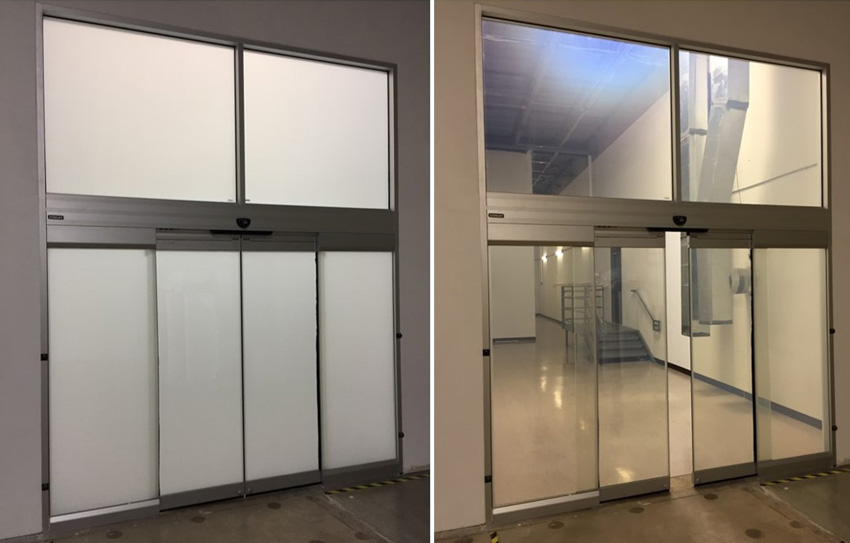
Photos courtesy of Polytronix, Inc.
Automatic sliding doors
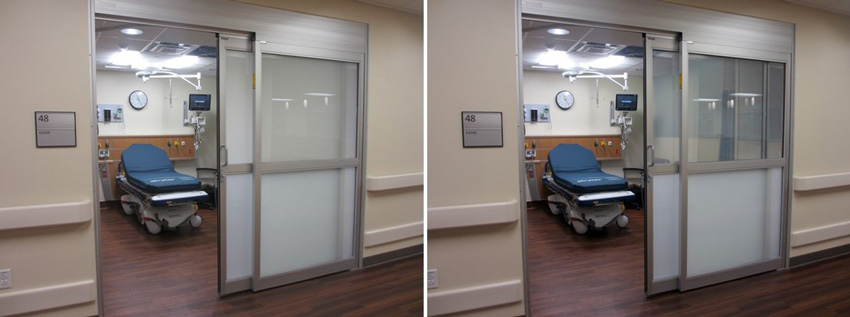
Photos courtesy of Polytronix, Inc.
Manual sliding doors
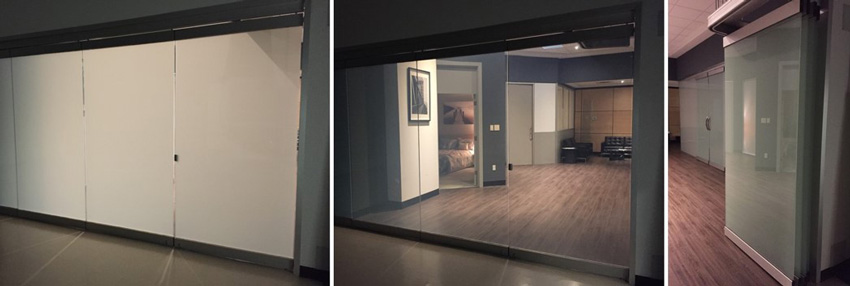
Photos courtesy of Polytronix, Inc.
Folding partition and doors
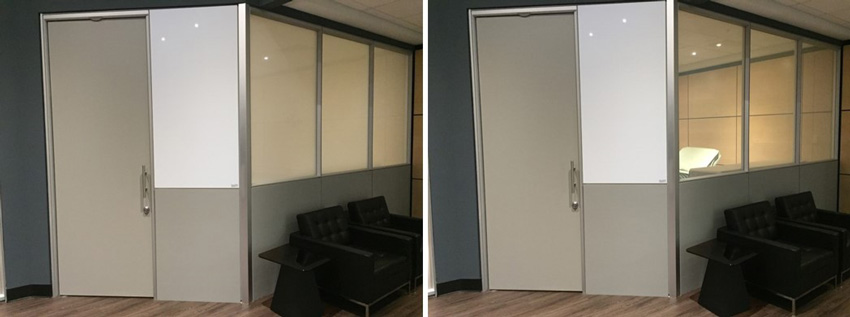
Photos courtesy of Polytronix, Inc.
Modular wall systems
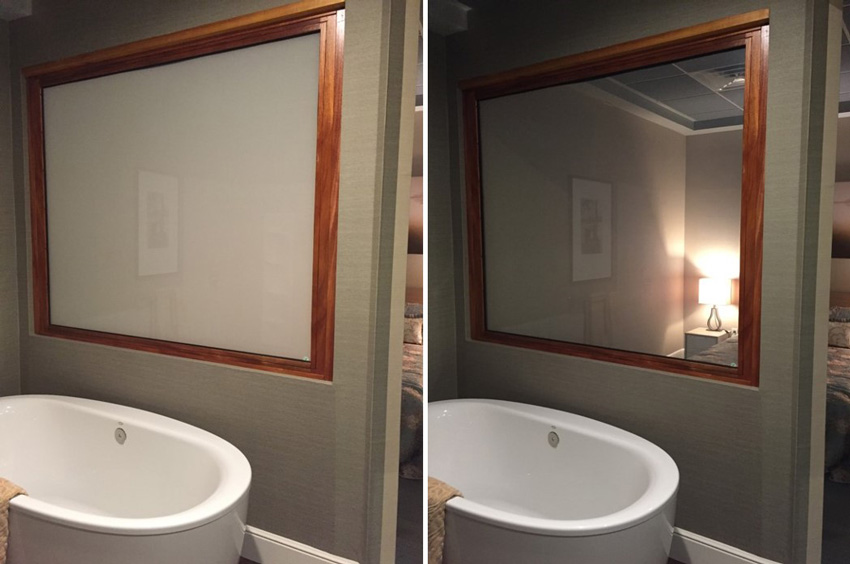
Photos courtesy of Polytronix, Inc.
Window framing
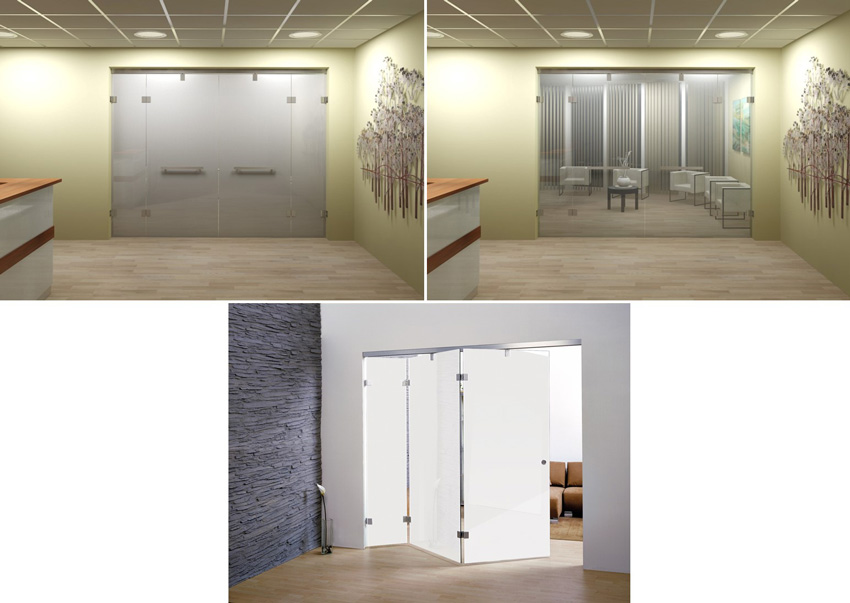
Photos courtesy of PR America/KL Megla
Frameless folding doors (no rails, minimalist design)
Emerging Trends
In addition to the commercial applications noted above, there are some other emerging trends regarding use of this technology, including residential retrofits. Industry leaders are also seeing increased use of the technology with rear projection on the glass, privacy folding partitions for boardrooms (open concept), as well as an uptick in usage in health-care environments as a means of infection control. The following two industry case studies touch upon some of these applications.
Conclusion
PDLC film-enabled glass products can provide ease of control, privacy-on-demand functionality, and a host of design benefits for a multitude of interior glazing applications, such as conference rooms, patient consultation rooms, and commercial-space bathrooms, to name a few. As smart glass technologies continue to evolve, these innovative solutions will surely continue to revolutionize the industry.
Robyn M. Feller is a freelance writer and editor specializing in the architecture, design, and construction industry. www.linkedin.com/in/robynfeller

|
Polytronix, Inc. a U.S. based company located in Richardson, Texas, has been an innovator in design, manufacturing, and marketing of liquid crystal displays for over 35 years. Our displays are used in medical, aviation, aerospace, marine, automotive, and other industrial applications. Our PolyvisionTM Switchable Privacy Glass continue to be a source of design inspiration worldwide. www.polytronixglass.com
|










